Pop some corn, dim the lights, lean back, and pretend that your computer monitor or phone display is a movie screen as we take a look at the first one hundred years of cinema in Fort Worth. We’ll break those one hundred years into ten-year increments.
1897
As the nineteenth century ended, Fort Worth had only a handful of theaters—for live entertainment. Most were variety theaters—Hurley’s, Holland’s, the Standard, the Front—whose performers presented nudge-nudge, wink-wink entertainment to habitues of Hell’s Half Acre. An exception was Greenwall’s Opera House, which had evolved out of the opera house built by Walter Huffman in 1883. Greenwall’s presented legitimate theater: opera, ballet, Shakespeare.
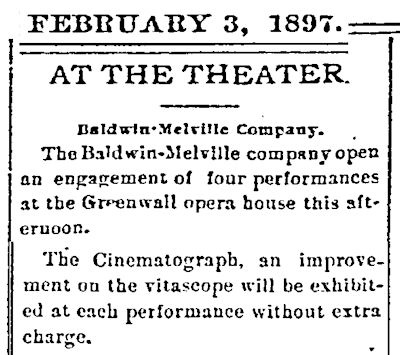 But on February 3, 1897 Greenwall’s Opera House presented something different: the future of entertainment. And it must have seemed like mechanical voodoo to the Greenwall’s wide-eyed audience: A clattering, whirring contraption projected flickering still images in rapid succession, creating the illusion of . . . motion!
But on February 3, 1897 Greenwall’s Opera House presented something different: the future of entertainment. And it must have seemed like mechanical voodoo to the Greenwall’s wide-eyed audience: A clattering, whirring contraption projected flickering still images in rapid succession, creating the illusion of . . . motion!
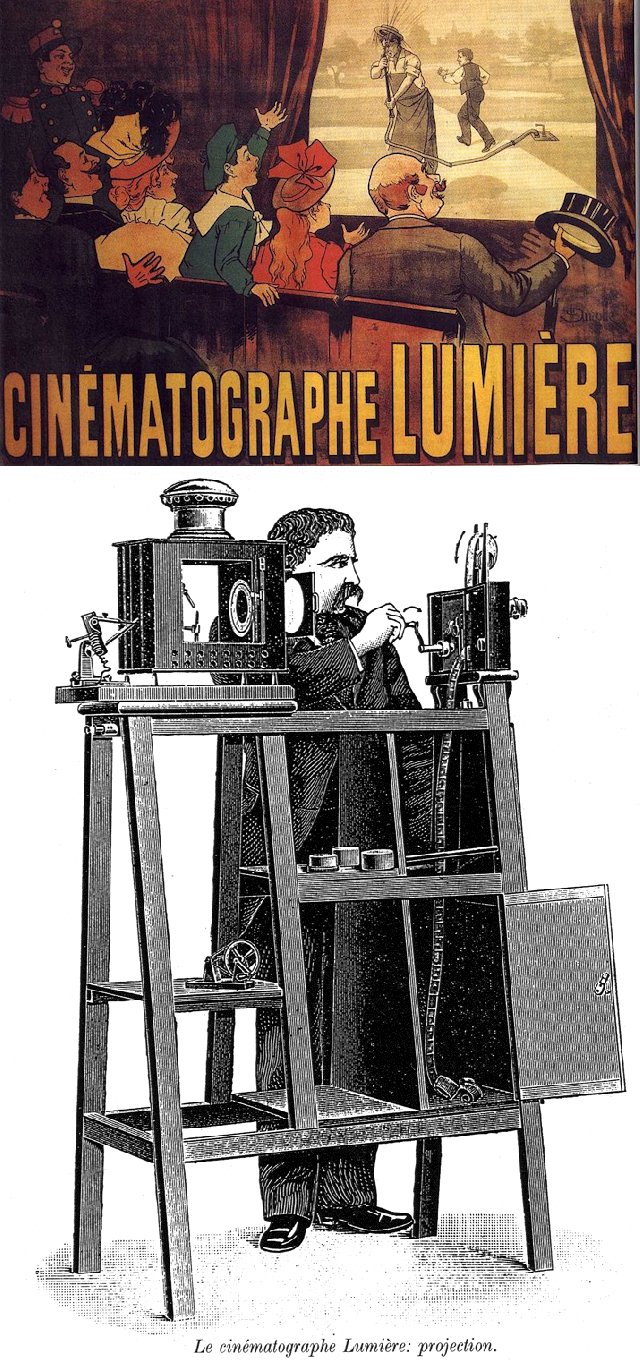 The Cinematograph—a rudimentary film projector—had been invented by the Lumiere brothers of France and first exhibited in Paris in 1895. (Photos from Wikipedia.)
The Cinematograph—a rudimentary film projector—had been invented by the Lumiere brothers of France and first exhibited in Paris in 1895. (Photos from Wikipedia.)
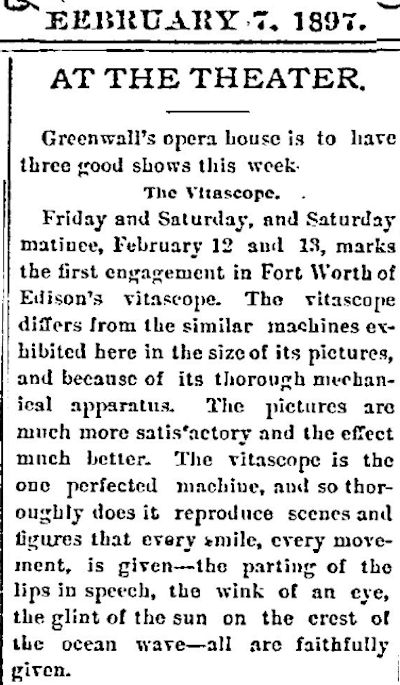 Four days after Greenwall’s February 3 announcement, Greenwall’s announced that it would present images using Edison’s Vitascope. The Vitascope, like the Cinematograph, was a rudimentary film projector.
Four days after Greenwall’s February 3 announcement, Greenwall’s announced that it would present images using Edison’s Vitascope. The Vitascope, like the Cinematograph, was a rudimentary film projector.
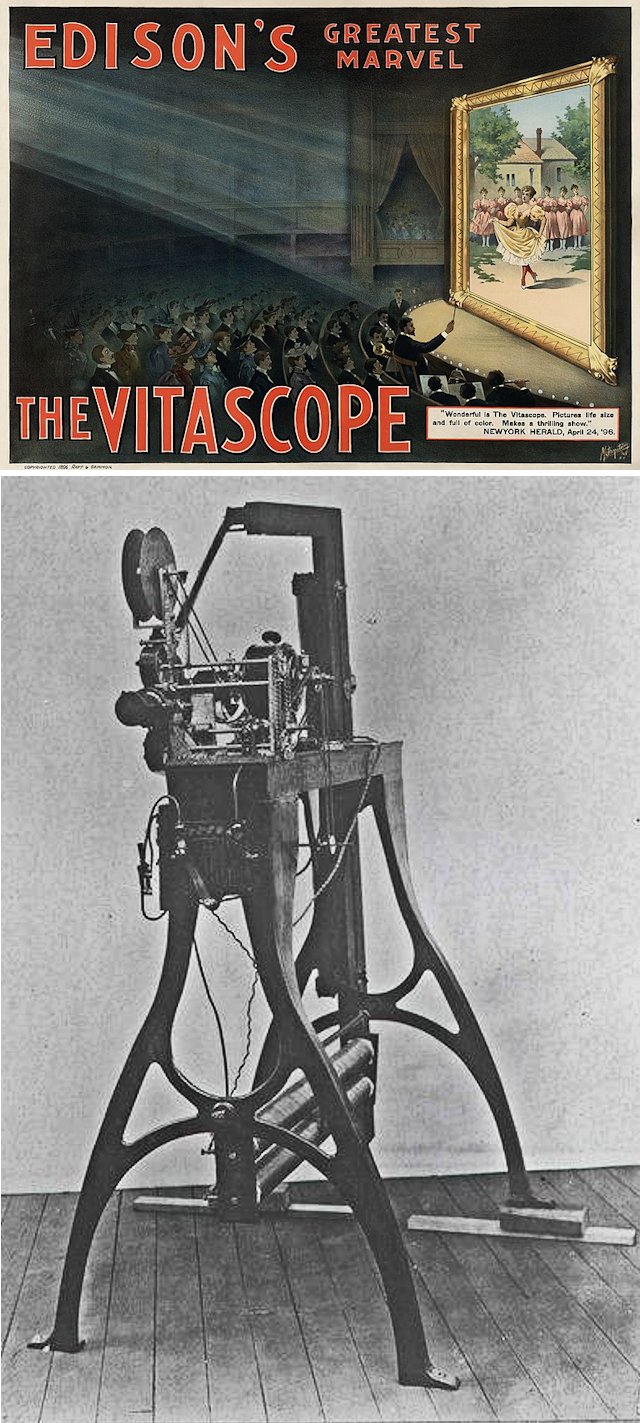 Thomas Edison had bought the rights to inventor Thomas Armat’s Phantoscope and renamed it the “Edison Vitascope.” It premiered in New York City in April 1896. (Photos from Wikipedia.)
Thomas Edison had bought the rights to inventor Thomas Armat’s Phantoscope and renamed it the “Edison Vitascope.” It premiered in New York City in April 1896. (Photos from Wikipedia.)
We don’t know the nature of the moving pictures that Greenwall’s patrons saw projected by those primitive machines in 1897. Patrons would have been captivated by anything that moved: perhaps just vignettes showcasing the potential of the new technology but having little or no plot.
Nary a shootout, car chase, or nude scene.
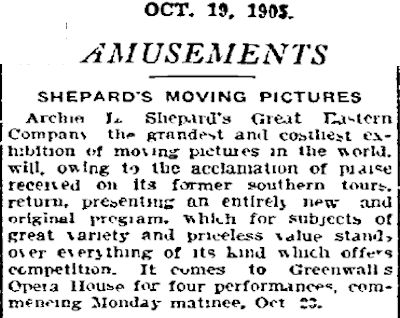 By 1905 Greenwall’s Opera House was still presenting moving pictures, although the theater continued to present far more live entertainment than film.
By 1905 Greenwall’s Opera House was still presenting moving pictures, although the theater continued to present far more live entertainment than film.
1907
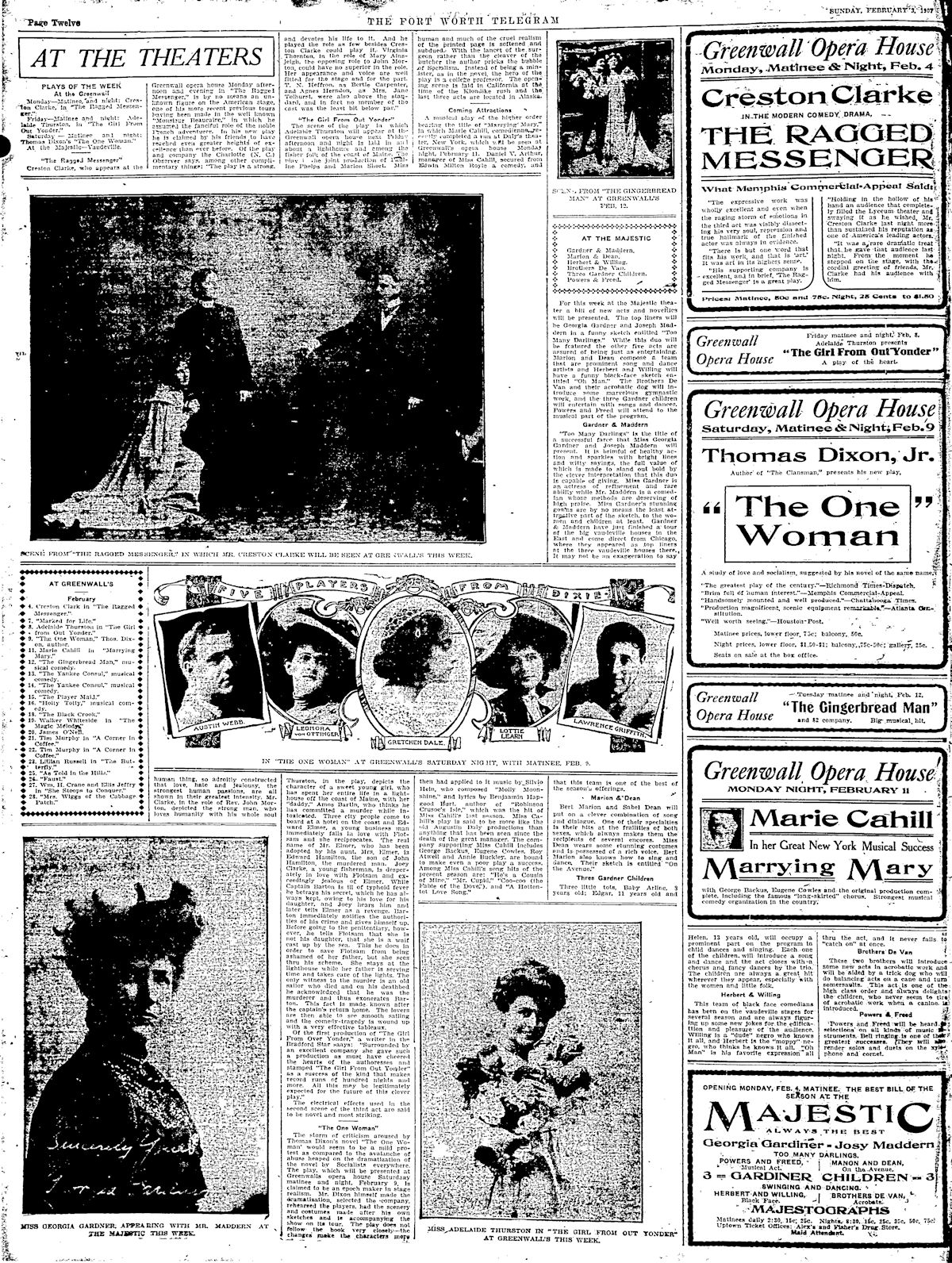 In fact, in 1907, ten years after Edison’s Vitascope had first dazzled audiences at Greenwall’s, film was still a fad. Live theater—increasingly vaudeville—remained the most popular form of entertainment. And Greenwall’s remained a major theater, but now it had competition: The original Majestic Theater had opened in 1905 on Jennings Avenue as part of the Interstate theater chain.
In fact, in 1907, ten years after Edison’s Vitascope had first dazzled audiences at Greenwall’s, film was still a fad. Live theater—increasingly vaudeville—remained the most popular form of entertainment. And Greenwall’s remained a major theater, but now it had competition: The original Majestic Theater had opened in 1905 on Jennings Avenue as part of the Interstate theater chain.
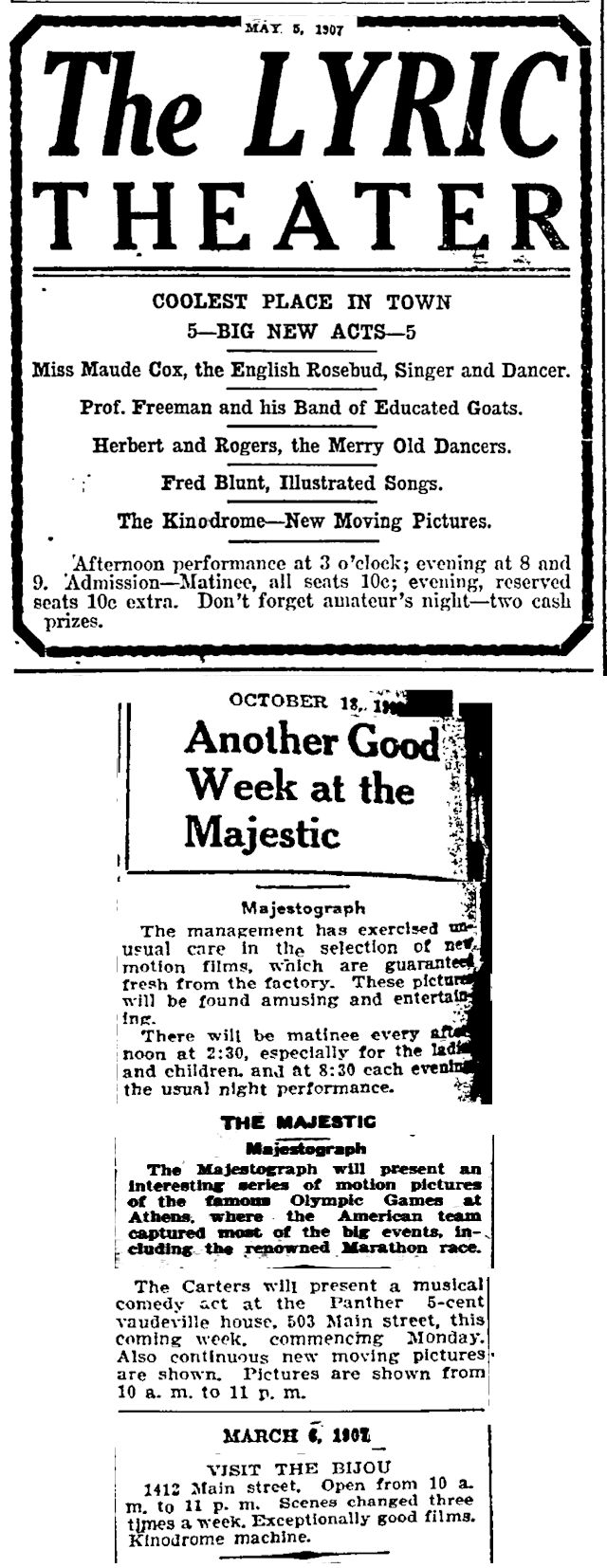 By 1907 the Majestic, Lyric, Panther, and Bijou theaters were among those in Fort Worth showing “moving pictures.” Rather majestically, the Majestic called its projector the “Majestograph.”
By 1907 the Majestic, Lyric, Panther, and Bijou theaters were among those in Fort Worth showing “moving pictures.” Rather majestically, the Majestic called its projector the “Majestograph.”
In 1911 the Majestic Theater moved to a new grand building on Commerce Street.
In 1915 the Star-Telegram reported that D. W. Griffith’s “much heralded” film Birth of a Nation had its Fort Worth premiere at the “packed” Byers Theater. “Its atmosphere was that of a circus or wild west show,” the newspaper wrote of the theater, as the movie “aroused the audience to a high pitch of enthusiasm.”
The Byers had opened on East 7th Street in 1908, replacing Greenwall’s Opera House.
1917
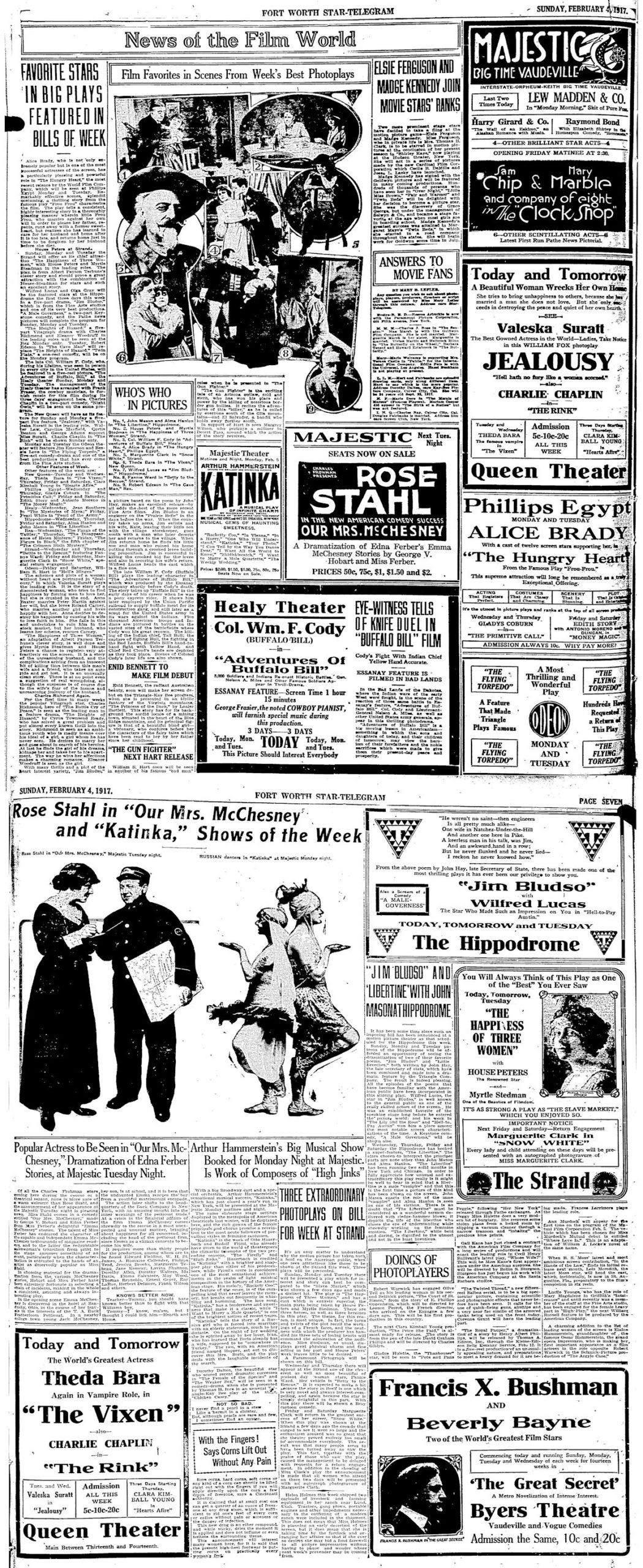 Ten years bring tremendous change in any age. By 1917, just as legitimate theater had yielded to vaudeville, vaudeville was yielding to movies. Now the Star-Telegram devoted two full pages to theater, both stage and film. But the stars of the stage were being pushed off the pages by the stars of movies, about whom readers could read in columns such as “Answer to Movie Fans,” “Who’s Who in Pictures,” and “Doings of Photoplayers.”
Ten years bring tremendous change in any age. By 1917, just as legitimate theater had yielded to vaudeville, vaudeville was yielding to movies. Now the Star-Telegram devoted two full pages to theater, both stage and film. But the stars of the stage were being pushed off the pages by the stars of movies, about whom readers could read in columns such as “Answer to Movie Fans,” “Who’s Who in Pictures,” and “Doings of Photoplayers.”
A sampling of motion pictures being shown around town in 1917: The Great Secret at the Byers, a Pathe newsreel at the Majestic, Charlie Chaplin at the Queen, The Hungry Heart at the Phillips Egypt, Adventures of Buffalo Bill at the Healy, and Jim Bludso at the Hippodrome. (The T in each corner of the Hippodrome ad stands for “Triangle Film Corporation,” an early California movie studio that made more than ninety short films in 1917 alone.)
In 1919 the owner of the Byers fully embraced the future and converted the Byers from a stage theater to a movie theater. The theater was renamed the “Palace.” The Palace opened on October 19 with The Hoodlum starring Mary Pickford. The Palace didn’t know it at the time, but it had just become the first of the three grand theaters of Fort Worth’s Show Row on 7th Street.
1927
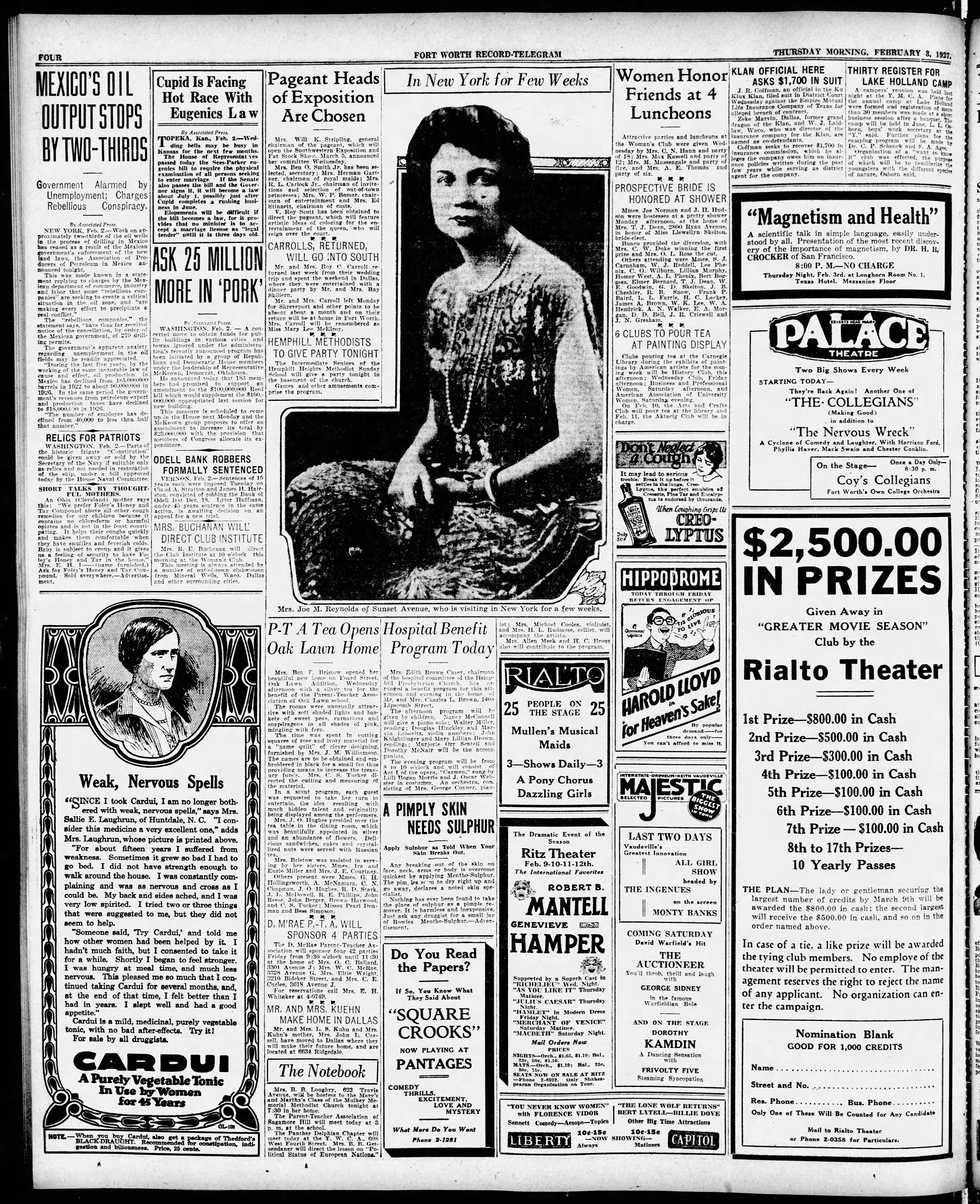 By 1927 all the movie theaters advertising on the Star-Telegram’s movie page still were located downtown, most of them located where the Acre had been.
By 1927 all the movie theaters advertising on the Star-Telegram’s movie page still were located downtown, most of them located where the Acre had been.
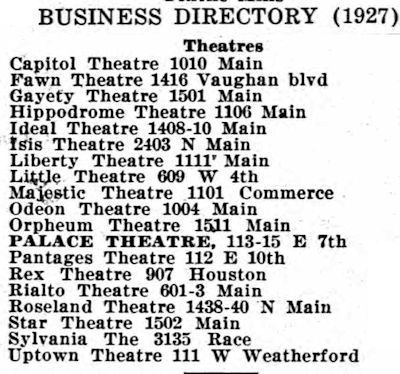 But the 1927 city directory lists four theaters that were not downtown: Roseland and Isis on the North Side, Sylvania in Riverside, and Fawn on Vaughn Boulevard in Poly.
But the 1927 city directory lists four theaters that were not downtown: Roseland and Isis on the North Side, Sylvania in Riverside, and Fawn on Vaughn Boulevard in Poly.
The year 1927 was a milestone for two legends of cinema: Fritz Lang’s Metropolis and Alfred Hitchcock’s The Lodger premiered. Both films were silent.
But the year brought an even bigger milestone: The musical drama The Jazz Singer, starring Al Jolson, was the first feature-length movie to feature not only a synchronized recorded music score but also lip-synchronous song and dialogue.
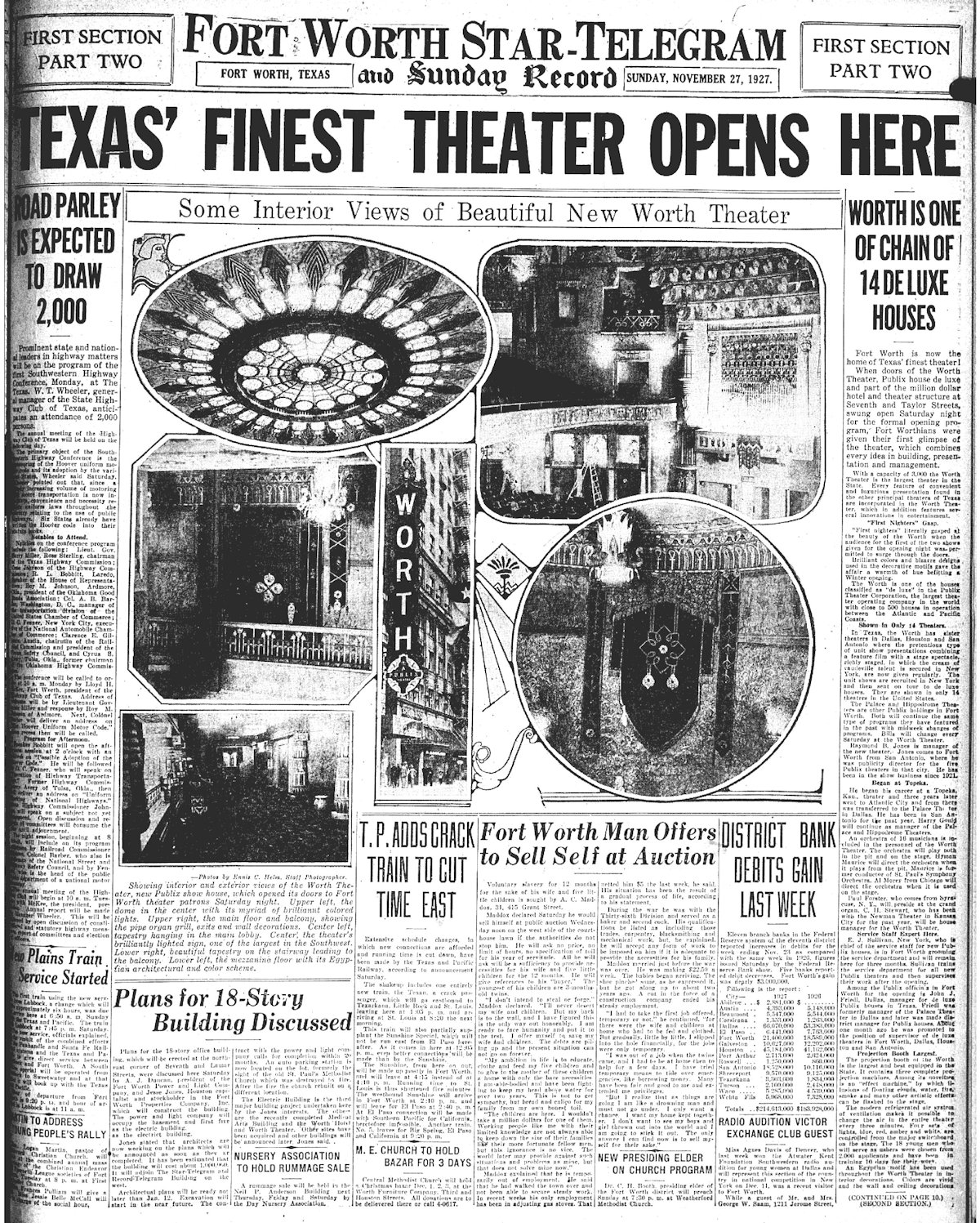 The year 1927 also was a milestone in Fort Worth’s cinematic history. Show Row got its second sibling on November 26 when the Worth Theater opened in the Worth Hotel.
The year 1927 also was a milestone in Fort Worth’s cinematic history. Show Row got its second sibling on November 26 when the Worth Theater opened in the Worth Hotel.
 The Worth Theater was opulent, featured a stage band, an orchestra, and, of course, the mighty Wurlitzer pipe organ with “Fort Worth’s own joy boy,” Billy Muth, at the keyboard.
The Worth Theater was opulent, featured a stage band, an orchestra, and, of course, the mighty Wurlitzer pipe organ with “Fort Worth’s own joy boy,” Billy Muth, at the keyboard.
And the theater was air-conditioned!
Although 1927 was the year of the talkie, the first film shown by the Worth Theater was the silent She’s a Sheik, starring Dallas-born Bebe Daniels.
 The Jazz Singer would not reach Fort Worth until 1928, opening at the Palace in April.
The Jazz Singer would not reach Fort Worth until 1928, opening at the Palace in April.
Two years later Show Row was complete as the Hollywood Theater opened on April 17, 1930.
The new theater was christened with a bottle of water from Lake Worth. The Hollywood boasted that it was Fort Worth’s first theater designed to show only talkies. Indeed, its first movie, Flight, was “all-talking.”
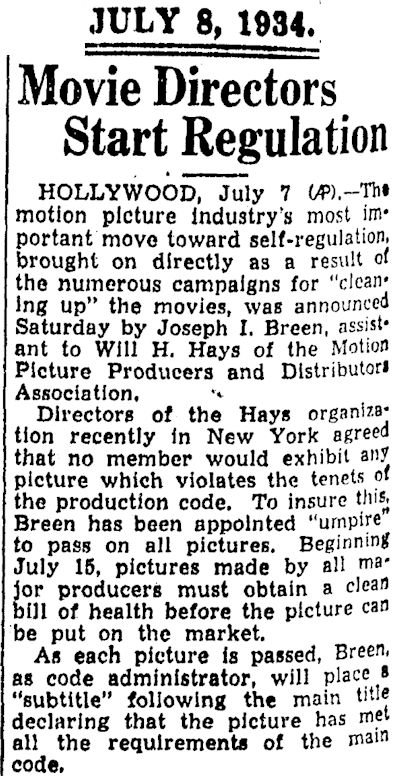 In 1934 the motion picture industry responded to complaints by beginning to police itself with the Motion Picture Production Code (Hays Code), which set guidelines related to language and the depiction of sex, violence, drugs, religion, and so on in films.
In 1934 the motion picture industry responded to complaints by beginning to police itself with the Motion Picture Production Code (Hays Code), which set guidelines related to language and the depiction of sex, violence, drugs, religion, and so on in films.
1937
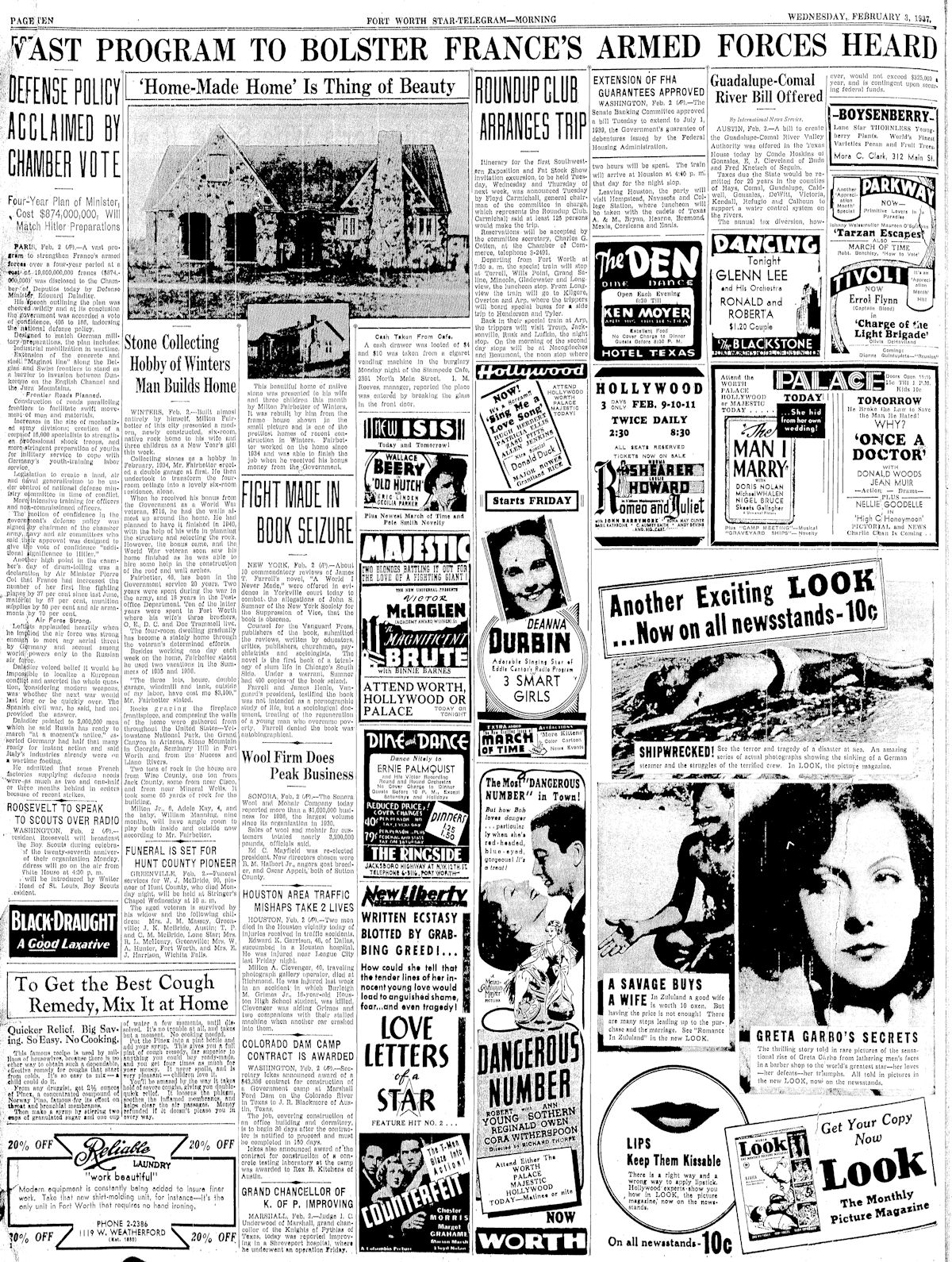 By 1937 7th Street’s Show Row was well established, and there were more neighborhood theaters: Parkway, Tivoli, and New Isis (the original Isis Theater was remodeled and enlarged in 1936 and reopened as the “New Isis Theater”).
By 1937 7th Street’s Show Row was well established, and there were more neighborhood theaters: Parkway, Tivoli, and New Isis (the original Isis Theater was remodeled and enlarged in 1936 and reopened as the “New Isis Theater”).
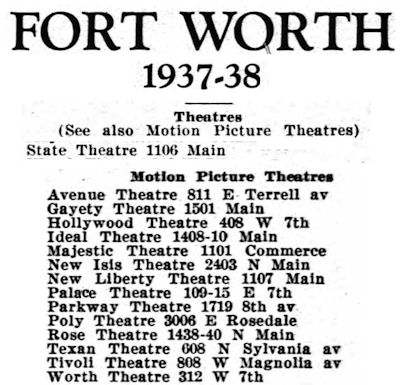 The 1937 city directory lists a few others: State, Avenue, Poly (which in 1938 would become the Varsity on Rosedale), and Texan.
The 1937 city directory lists a few others: State, Avenue, Poly (which in 1938 would become the Varsity on Rosedale), and Texan.
The three years 1939-1941 brought three film classics to town:
 In 1939 the Worth Theater hosted Dorothy, her traveling companions, two witches, and assorted Munchkins and winged monkeys.
In 1939 the Worth Theater hosted Dorothy, her traveling companions, two witches, and assorted Munchkins and winged monkeys.
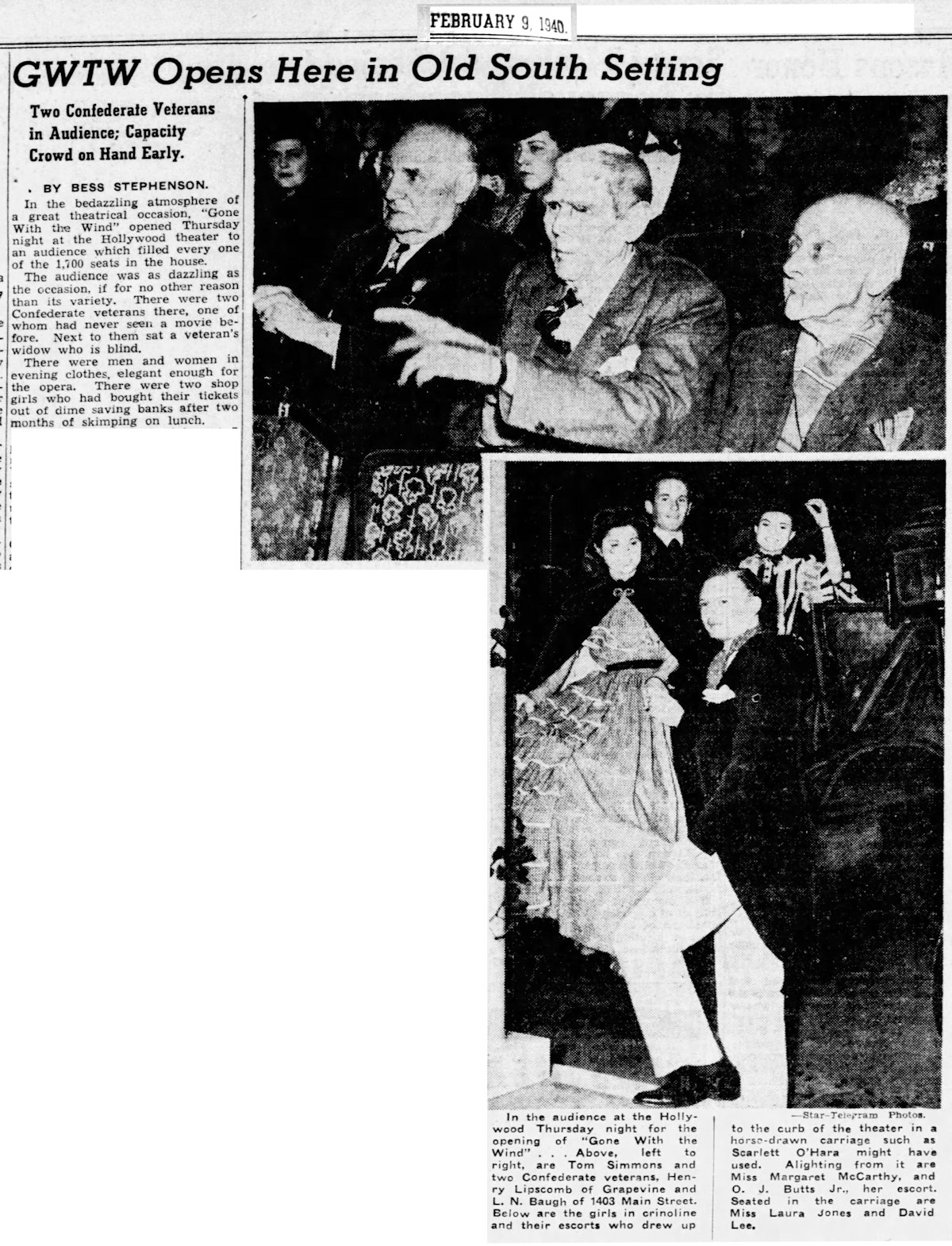 The Hollywood Theater during its long career hosted many of its era’s movie galas. One of the early galas was the Fort Worth opening of Gone With the Wind on February 8, 1940.
The Hollywood Theater during its long career hosted many of its era’s movie galas. One of the early galas was the Fort Worth opening of Gone With the Wind on February 8, 1940.
Members of the audience entered the theater after walking between the white columns of a simulated southern mansion erected on the sidewalk. Some people arrived at the theater in horse-drawn carriages. Every seat in the theater was filled. In the audience were two Civil War veterans—one of whom had never seen a movie—and six widows of veterans. (And, yes, the theater drafted its African-American porter to act as a “negro carriage boy . . . to help the patrons from their automobiles.”)
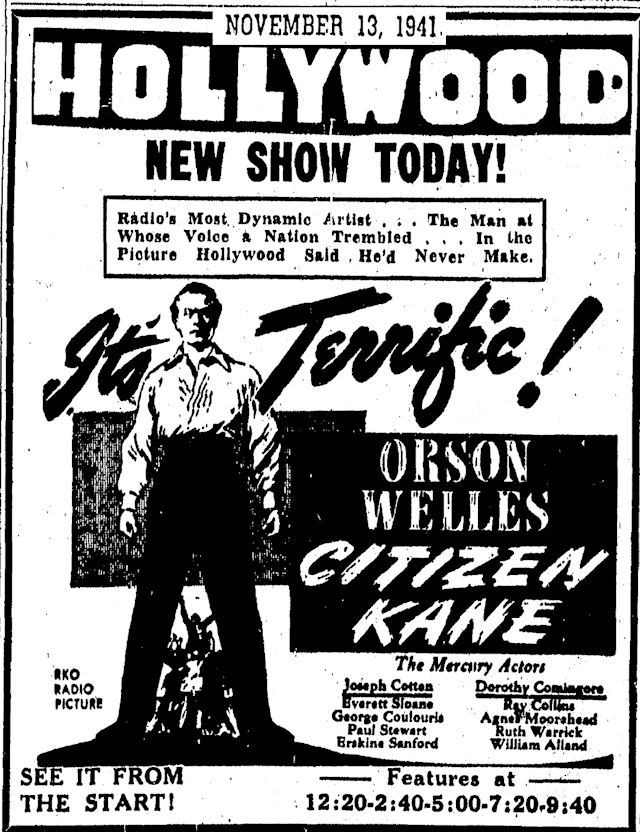 A year later, 1941, the Hollywood Theater was the first local theater to show Citizen Kane.
A year later, 1941, the Hollywood Theater was the first local theater to show Citizen Kane.
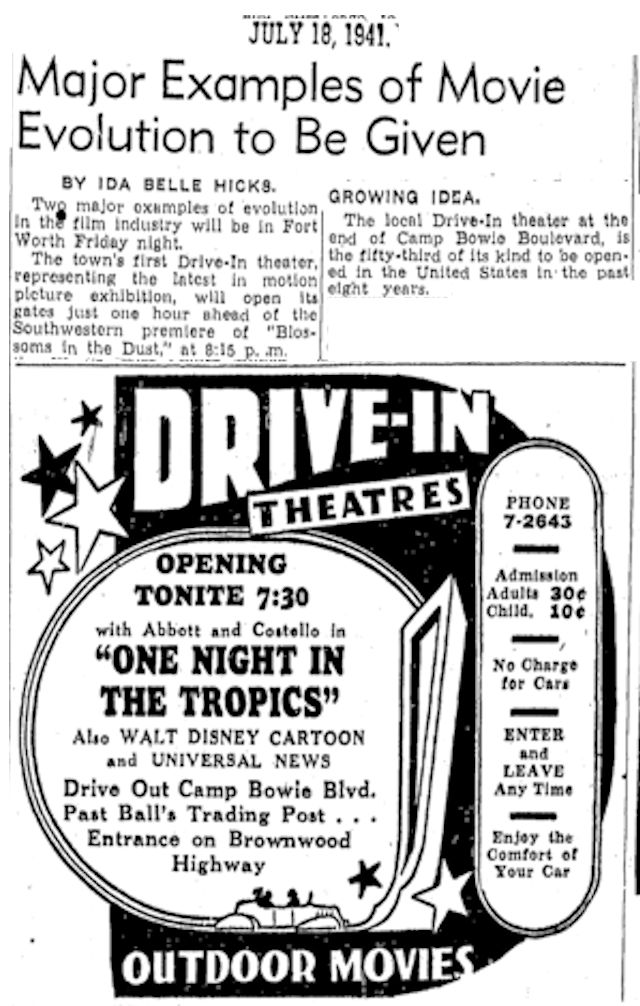 That same year Fort Worth’s first drive-in theater opened “at the end of Camp Bowie Boulevard” (7100 block where Neiman Marcus would be built). The Bowie Boulevard drive-in theater, also called just the “Boulevard,” opened on the night that Blossoms in the Dust (about Edna Gladney) premiered at the Worth Theater.
That same year Fort Worth’s first drive-in theater opened “at the end of Camp Bowie Boulevard” (7100 block where Neiman Marcus would be built). The Bowie Boulevard drive-in theater, also called just the “Boulevard,” opened on the night that Blossoms in the Dust (about Edna Gladney) premiered at the Worth Theater.
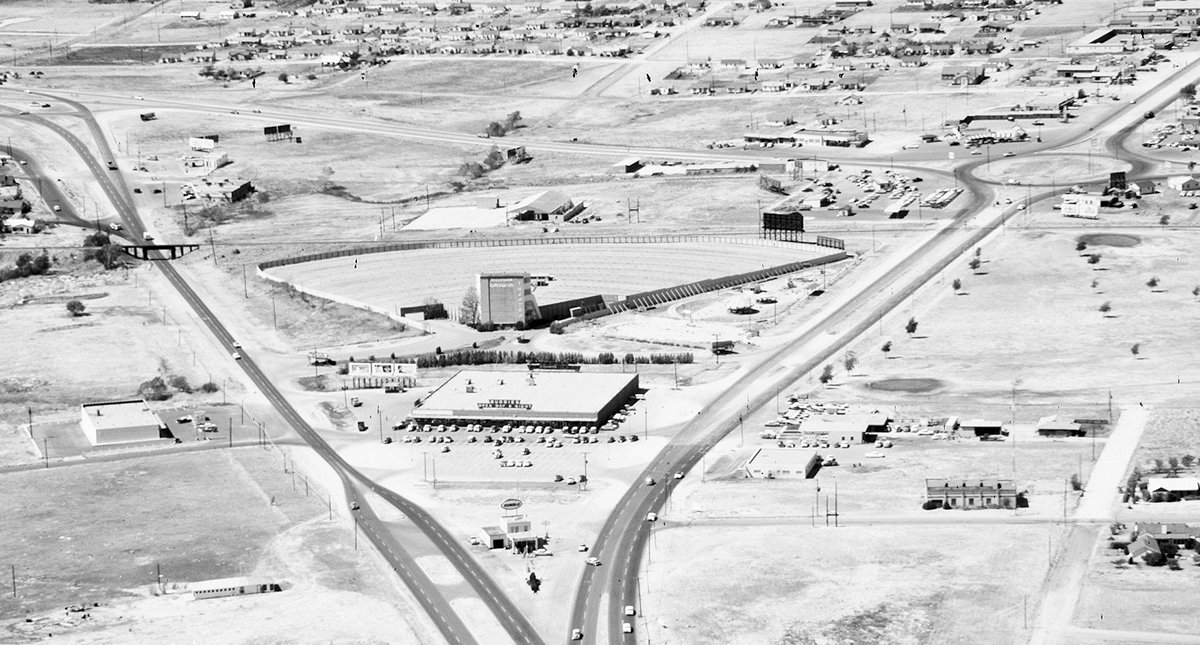 This aerial photo shows plenty of elbow room on the western edge of town in 1955. Looking west, it also shows the bomber spur trestle (left) over Camp Bowie Boulevard, the Weatherford traffic circle (right), and, in the fork of U.S. 80 and Camp Bowie Boulevard, the Bowie Boulevard drive-in theater and a Buddie’s supermarket. (Photo from University of Texas at Arlington Libraries Special Collections.)
This aerial photo shows plenty of elbow room on the western edge of town in 1955. Looking west, it also shows the bomber spur trestle (left) over Camp Bowie Boulevard, the Weatherford traffic circle (right), and, in the fork of U.S. 80 and Camp Bowie Boulevard, the Bowie Boulevard drive-in theater and a Buddie’s supermarket. (Photo from University of Texas at Arlington Libraries Special Collections.)
Lights up! Forty-four years of cinema in Fort Worth is enough for one sitting. Time for intermission. Stand up and stretch. Last one to the lobby is a Milk Dud!






Oh wow! So cool that the original Majestic, built by my great-grandfather William J Bailey, was one of the first to show moving pictures in Fort Worth!!
By the way, I have a journal by my grandfather John T Bailey when he was a teenager, in the early 1930s mentioning names of movies he went to see! He and his family enjoyed going to the movies every week! I found it interesting to look up the movies online.